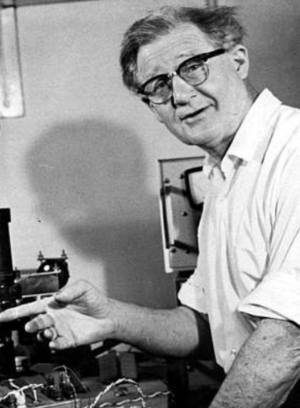W. A. H. Rushton facts for kids
Quick facts for kids
W. A. H. Rushton
|
|
|---|---|
 |
|
| Born | 8 December 1901 |
| Died | 21 June 1980 (aged 78) |
| Occupation | Physiologist, psychical researcher |
William Albert Hugh Rushton (born December 8, 1901 – died June 21, 1980) was a brilliant scientist. He was a professor of Physiology at Trinity College, Cambridge University. Physiology is the study of how living things work. Rushton was most interested in how we see colours. His important idea, called the Principle of Univariance, helps us understand how our eyes and brain see the world.
Learning and Life
William Rushton went to Gresham's School and then to the University of Cambridge. He studied at different colleges there, including Pembroke, Emmanuel, and Trinity. He loved music and played several instruments, like the violin and bassoon. He even wrote some music himself! In 1930, he married Marjorie Kendrick, who played the oboe.
How We See Colour
Rushton came up with a very important idea about how we see colours. It's called the Principle of Univariance. He explained it like this: "The output of a receptor depends upon its quantum catch, but not upon what quanta are caught."
This means that a single light-sensing cell in your eye can react to different kinds of light. It might react to bright red light or dim blue light in a similar way. Because of this, your brain can't tell the exact colour just from one cell. It needs information from many different cells to figure out the true colour.
Investigating Strange Events
Rushton was also interested in parapsychology. This is the study of things that seem to be beyond normal science, like mind reading or ghosts. From 1969 to 1971, he was the leader of the Society for Psychical Research. This group tries to study these strange events in a scientific way.
Rushton was known for finding normal, scientific reasons for things that people thought were paranormal. For example, he looked into a man named Ted Serios. Serios claimed he could make pictures appear on film using only his mind, a process called Thoughtography. Rushton showed how Serios might have used a hidden device to trick people. He thought Serios used a tiny picture placed in front of the camera lens. Rushton even copied Serios's trick using a small prism with a microfilm picture inside it. This showed that the "psychic photographs" could be made without any special powers.
Awards and Recognitions
Rushton received many awards for his important work:
- 1931 Beit Memorial Fellowship
- 1948 Became a Fellow of the Royal Society (a very respected group of scientists)
- 1968 Became a Foreign Member of the Royal Swedish Academy of Sciences
- 1969 Received an honorary science degree (DSc) from Case Western Reserve University
- 1970 Won the Royal Medal from the Royal Society

